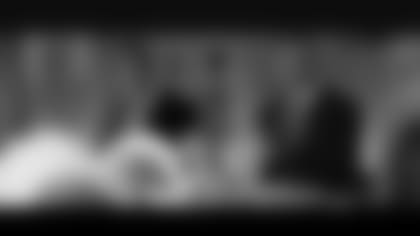The scoreboard says the Bears lost to Green Bay 23-16 on Sunday at Soldier Field, a difference of seven points. But the contest was somehow even closer than one touchdown and an extra point. The game's most important play was decided by mere inches, the difference in space between a foot staying in-bounds or going out, and a ball touching a pylon or missing it.
In the second quarter of the Week 10 game between the NFL's oldest rivals, Chicago called up seemingly the perfect play at the perfect time. Facing third-and-13 from the Green Bay 25, the Bears expected pressure from Packers defensive coordinator Dom Capers. Trailing 10-3 at the time, the last thing the Bears wanted was a sack to potentially knock the team out of field-goal range. So instead of a running a play with a high amount of risk or reward, Chicago played it safe, dialing up a screen pass for running back Benny Cunningham.
In a shotgun formation with Cunningham to his left, quarterback Mitchell Trubisky took the snap and acted as if he was looking for a receiver downfield. Cunningham released from his blocking stance and leaked out to the right side of the formation, where there wasn't much besides green grass in front of him. The rookie quarterback tossed him a perfect pass the running back could catch as he moved, and then Cunningham followed his lead blocker, right guard Cody Whitehair, down the field. Cunningham made Green Bay cornerback Damarious Randall miss, then cut toward the sideline. At the 10-yard line, when the back had made the first down, Cunningham was met by Packers safety Marwin Evans, who bumped him but was unable to bring him down. Cunningham kept going, but by the time he reached the 3, it appeared he was going to be out of bounds before reaching the end zone.

Bears running back Benny Cunningham pleads his case after being ruled short of the goal line against the Packers.
Instead of falling out, Cunningham dove and reached with both arms for the pylon. At the exact moment he was extending his arms, Evans bumped him again, knocking the ball ever-so-slightly out of the runner's hands as he made contact with the pylon before landing on the ground. Referee Tony Corrente stated that Cunningham stepped out at the Green Bay 2-yard line before he dove, meaning the play was a 23-yard gain to give Chicago first-and-goal.
However before Trubisky took another snap, coach John Fox threw his red challenge flag on the field, asking the refs to take a second look to see if the running back had scored before landing out of bounds. Cunningham had told the coach when he got to the sideline he felt he was in the end zone, and Fox was looking to tie the game right then and there.
"Honestly, I thought I was in," Cunningham said after the game. "Just trying to compete and make a play for the team."
Fox asked Corrente to check if Cunningham had reached the end zone before going out. Instead Corrente came back, after looking at replays and speaking with NFL Senior VP of Officiating Alberto Riveron at league headquarters in New York, to say that the running back lost control of the ball when he was in the air and had fumbled out of the end zone. The touchback gave Green Bay possession at the Chicago 20-yard line, ending the drive with no points. Chicago technically won the challenge and was not charged a timeout, yet came away with nothing to show for it.
Corrente told a pool reporter following the contest that the officials pieced together a pair of replays to determine if Cunningham retained or lost possession of the ball before reaching the end zone.
"Looking at the review, (Cunningham) did not step out of bounds and started lurching toward the goal line (with both hands on the ball)," the referee said. "As he was lunging toward the goal line, he lost the ball in his right hand first, probably, I'm going to guess, 2 feet maybe short of the pylon. As he got even closer, the left hand came off. We had to put together two different angles in order to see both hands losing the football. After he lost it the second time, it went right into the pylon. Which creates a touchback."
"I feel like we were rolling as an offense," Cunningham said, taking full responsibility for the fumble after the game. Running backs are taught to not try and push the ball over the goal line unless its fourth down because of the exact issue that the Bears faced on Sunday. "I feel like that play did have a big impact on the game. Worst-case scenario, we walk away with three points in that situation. You never want to leave points on the field. It most definitely played a big part in today's game."
It took the Bears a while to recover from the touchdown that wasn't. Chicago punted on three of its next four drives after the fumble, gaining a total of four first downs on those four possessions. Players in the locker room said that they tried to move on from the play, but that the loss of a scoring chance was important in the end.
"Obviously, those are the types of plays that we need to go in our favor, with either a touchdown or a first-and-10 on the goal line, in order to give us a better chance of winning," Trubisky said.
The Bears still had a chance to tie the game late in the fourth quarter, trailing by seven points. The rookie quarterback attempted to lead the offense down the field, but just didn't have enough to get through a physical Packers defense. Seven points on the scoreboard proved to be the difference, but impossible to say what it would have been had Cunningham's toe clearly stepped out before he dove towards the end zone, or his fingers held on to the ball just a little bit longer.













